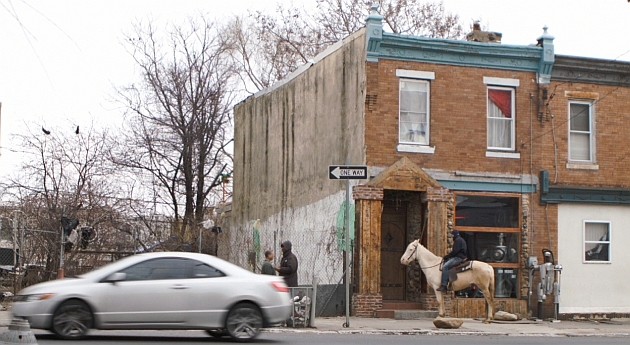Capsule 02: Mohamed Bourouissa
24 Oct 2014 - 11 Jan 2015

Film still "Horse Day", Mohamed Bourouissa, 2014 © Courtesy the artist and kamel mennour, Paris, Production: mobile
Capsule 02: MOHAMED BOUROUISSA
24 October 2014 - 11 January 2015
Haus der Kunst has inaugurated a new program of focused one gallery exhibitions that explore recent developments amongst a generation emerging international artists. The goal of the Capsule Exhibition series is to engage audiences in the production of new works by artists at critical points of artistic breakthrough in their careers.
Through his multimedia works, the French-Algerian artist Mohamed Bourouissa (born 1978) investigates strategies of subjectivation and representation that reside in the social, cultural, and economical margins of society. As part of the Capsule exhibitions, Mohamed Bourouissa presents his latest work "Horse Day" (2014). For several months, the artist lived in Philadelphia, where he explored the world of an inner-city equestrian stable, creating a film, photographic works, and a series of sculptures.
Horses have been part of Philadelphia's cityscape since the 1960s. Initially they transported vegetables, fruit, milk and household items; later they served the leisure of their owners. The stables offer many young men an attractive way to spend their time, and in caring for the animals, they also develop a sense of responsibility. For the artist, these young people and their urban environment embody a subversive model of the cowboy that replaces the outdated stereotype of the – always fair-skinned – Marlboro or western cowboys.
The focal action in Mohamed Bourouissa's film is the "horse tuning": Before the competition, an obstacle course, the horses are "souped up" and presented in a kind of pageant to the jury and the audience. The costumes are created in collaboration with contemporary artists from Philadelphia. Through the "tuning" of the horses, the environment of the largely socially disadvantaged young people is transformed into a fantastic setting in which the horse and rider nearly merge into a wondrous and almost apocalyptic figure. The introduction of the fantastic creates a space that allows the redefinition of one's identity.
With the kind support of Bureau des arts plastiques / Institut français and the French Ministry of Culture and Communication
24 October 2014 - 11 January 2015
Haus der Kunst has inaugurated a new program of focused one gallery exhibitions that explore recent developments amongst a generation emerging international artists. The goal of the Capsule Exhibition series is to engage audiences in the production of new works by artists at critical points of artistic breakthrough in their careers.
Through his multimedia works, the French-Algerian artist Mohamed Bourouissa (born 1978) investigates strategies of subjectivation and representation that reside in the social, cultural, and economical margins of society. As part of the Capsule exhibitions, Mohamed Bourouissa presents his latest work "Horse Day" (2014). For several months, the artist lived in Philadelphia, where he explored the world of an inner-city equestrian stable, creating a film, photographic works, and a series of sculptures.
Horses have been part of Philadelphia's cityscape since the 1960s. Initially they transported vegetables, fruit, milk and household items; later they served the leisure of their owners. The stables offer many young men an attractive way to spend their time, and in caring for the animals, they also develop a sense of responsibility. For the artist, these young people and their urban environment embody a subversive model of the cowboy that replaces the outdated stereotype of the – always fair-skinned – Marlboro or western cowboys.
The focal action in Mohamed Bourouissa's film is the "horse tuning": Before the competition, an obstacle course, the horses are "souped up" and presented in a kind of pageant to the jury and the audience. The costumes are created in collaboration with contemporary artists from Philadelphia. Through the "tuning" of the horses, the environment of the largely socially disadvantaged young people is transformed into a fantastic setting in which the horse and rider nearly merge into a wondrous and almost apocalyptic figure. The introduction of the fantastic creates a space that allows the redefinition of one's identity.
With the kind support of Bureau des arts plastiques / Institut français and the French Ministry of Culture and Communication
